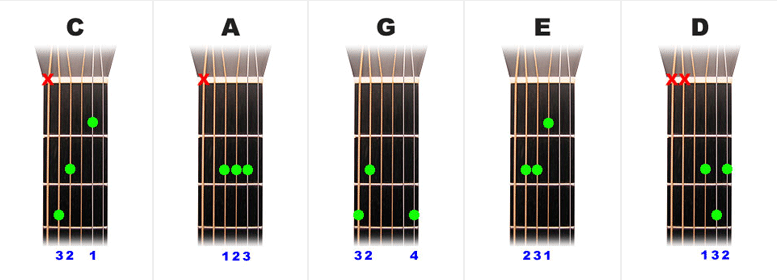The Open Major Chords
Chords, chords, chords ... I have been playing since 1961 and I still learn more about chords just about every time I pick up the guitar. I find them endlessly fascinating and never tire of exploring them. You will see, as you progress, just how important chords are and how powerful they are, not just sonically, but as tools to help you track melody and harmony ...▼
Chords are the most important thing to concentrate on. Names of notes, scales, modes, key signatures — all of that stuff is important to know — but put it on the back burner for now. Chords underlie every piece of music you will ever encounter, chords are what you'll be following when you join a band or learn a song, chords determine what notes your melody lines, riffs and licks will need to consist of, so I highly recommend that you learn as much about chords as you can and that you always make it your priority. There is a lot to learn about music, but you will find that chords encapsulate a good portion of it all, so by knowing chords, you'll also be learning a lot of the other stuff. Lets first look at what are known as the open chords which are those that use some of the open strings of the guitar. They are the most basic of guitar chords, so learn them well.
There are two main flavors of chords in music: major and minor. We'll look at the majors first as they are the 'standard' against which all other chords are measured. On a guitar, there are 5 open major chords. It's the way the guitar is tuned and the fact that it has six strings that determines the 'shapes' of these five chords, nothing else. Alphabetically, they are A, C, D, E, and G (there's no need to add the word 'Major' after these letters; when nothing is written, they are understood to be major). There are no open B and F open chords. You'll be finding out more about these five chords later on, and you'll find them written in a different order, one that forms a word: CAGED. Let's stick to referring to them in that order from now on. 'Caged' just happens to be the word formed by these five letters but there's no hidden meaning.
Here are the 5 open major chords
The green dots show you where to put your fingertips. The red crosses mean 'Don't pluck/play this string'.
The blue numbers indicate the best left-hand fingers to use.
1 = index | 2 = middle | 3 = ring | 4 = pinkie.

The important thing to remember about these five chords is that they all have the same quality, or 'flavor': they are all major. They look different because of the way the guitar is tuned and because the strings end at the nut, but they are all made up of the same ingredients, namely the first (1), third (3) and fifth (5) notes of their scale, and therefore they all have the same sound quality: major.
Chords are usually played with the root as the lowest note in pitch and it's the note the chord is named after. The root is also known as the tonic, 'The One' or the number 1, meaning the first note of the scale. That's why in three cases there are bass strings you should not play because the root is on a higher string. The red crosses show that in these diagrams.
Here they are again showing roots, thirds and fifths


Join Our Free Trial
Get started today before this once in a lifetime opportunity expires.
